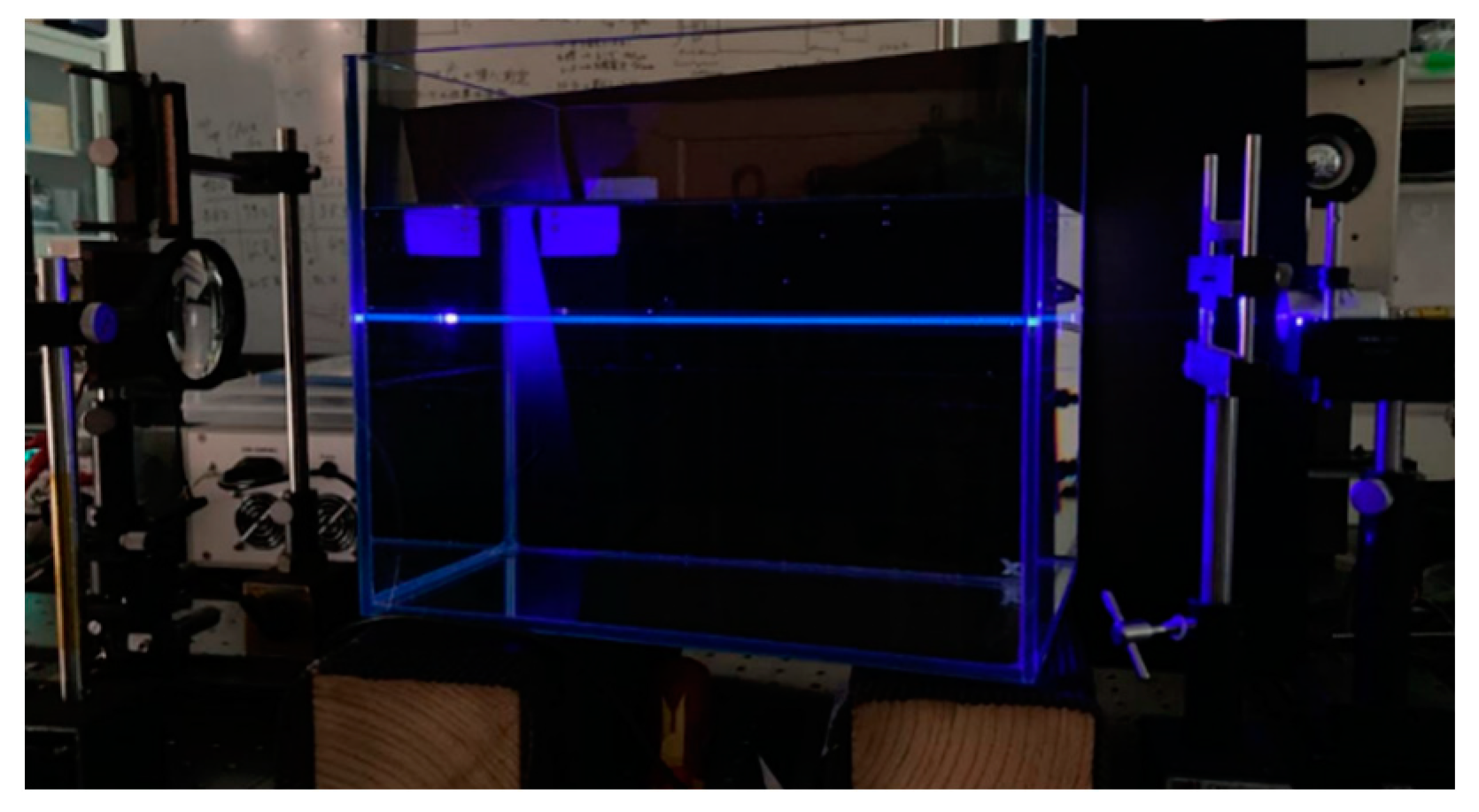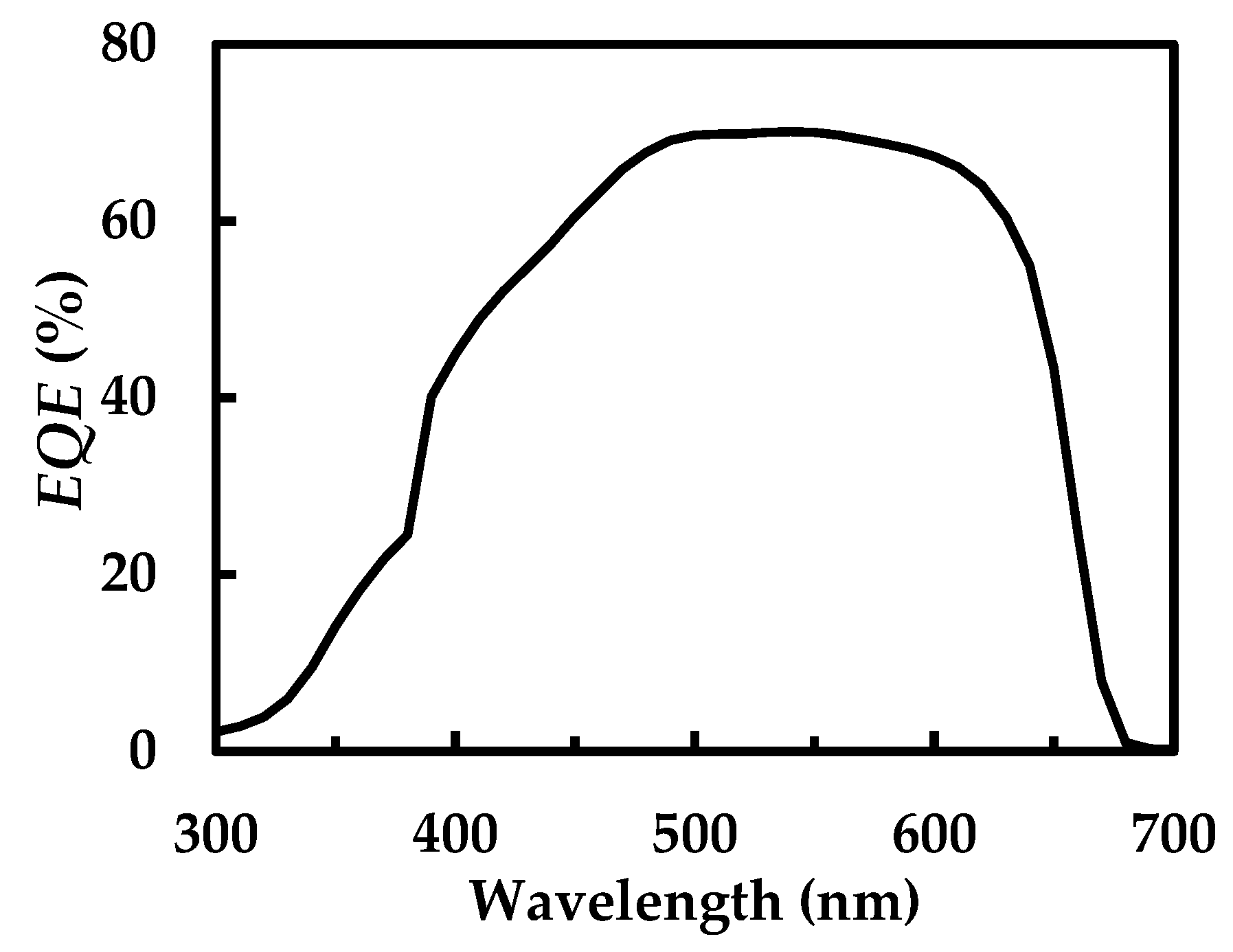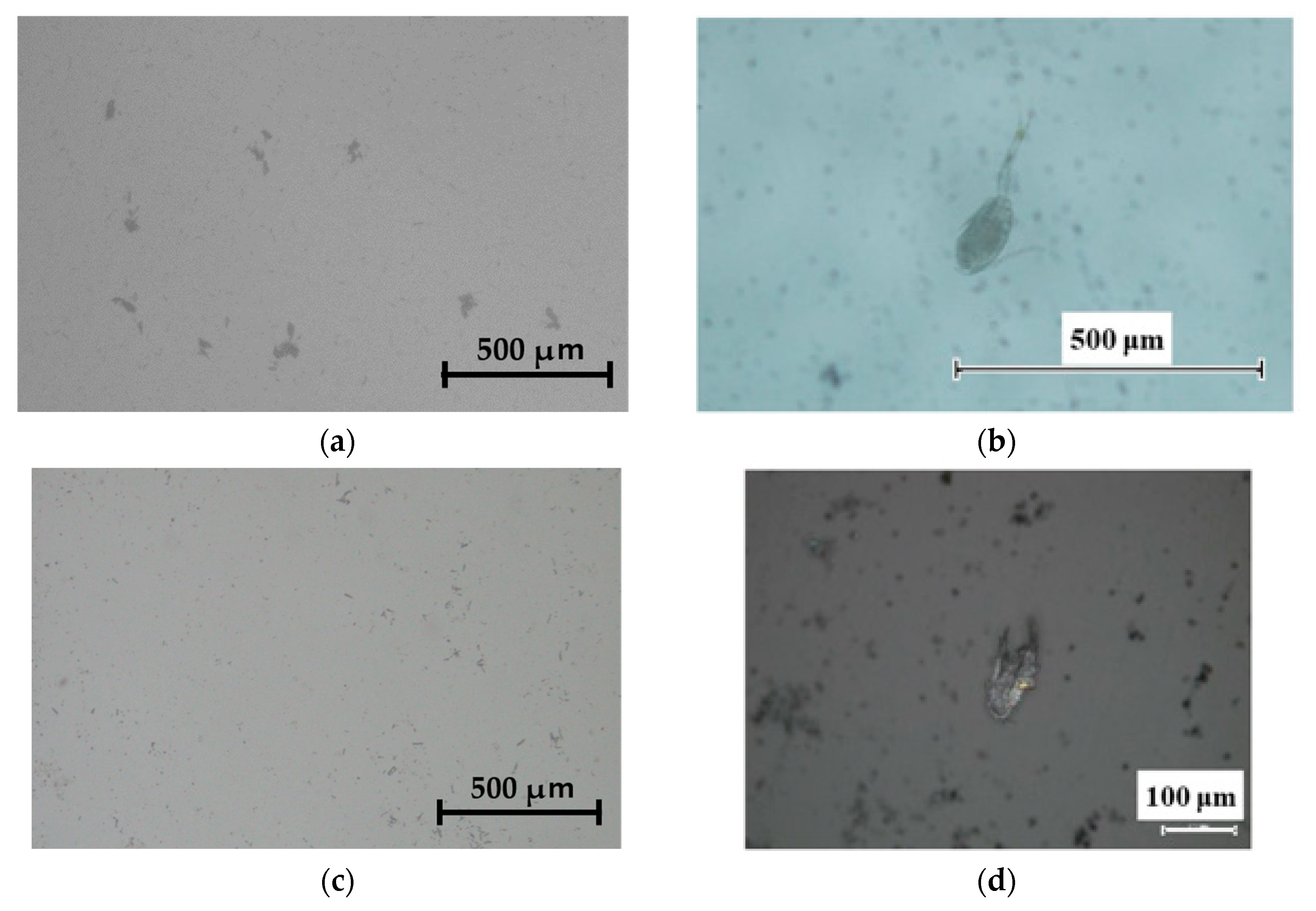Optical Wireless Power Transmission under Deep Seawater Using GaInP Solar Cells
Abstract
1. Introduction
2. Materials and Methods
3. Results and Discussion
4. Conclusions
Author Contributions
Funding
Institutional Review Board Statement
Informed Consent Statement
Data Availability Statement
Acknowledgments
Conflicts of Interest
References
- Caldeirinha, R.F.S.; Fernandes, T.R.; Richter, J.; AI-Nuaimi, M.O. Simplified RET model derived from path loss and directional spectrum measurements in vegetation media at 11.2 and 20 GHz. IET Microw. Antennas Propag. 2016, 11, 136–143. [Google Scholar] [CrossRef]
- Miller, J.M.; Onar, O.C.; Chinthavali, M. Primary-side power flow control of wireless power transfer for electric vehicle charging. IEEE J. Emerg. Sel. Top. Power Electron. 2015, 3, 147–162. [Google Scholar] [CrossRef]
- Steinsiek, F.; Weber, K.H.; Foth, W.P.; Foth, H.J.; Schafer, C. Wireless power transmission experiment using an airship as relay system and a moveable rover as ground target for later planetary exploration missions. In Proceedings of the 8th ESA Workshop on Advanced Space Technologies for Robotics and Automation, Noordwijk, The Netherlands, 2–4 November 2004; pp. 1–10. [Google Scholar]
- Nguyen, D.H. Dynamic Optical Wireless Power Transfer for Electric Vehicles. IEEE Access 2023, 11, 2787–2795. [Google Scholar] [CrossRef]
- Fafard, S.; Masson, D.P. 74.7% Efficient GaAs-based laser power converters at 808 nm at 150 K. Photonics 2022, 9, 579. [Google Scholar] [CrossRef]
- Helmers, H.; Lopez, E.; Höhn, O.; Lackner, D.; Schön, J.; Schauerte, M.; Schachtner, M.; Dimroth, F.; Bett, A.W. 68.9% Efficient GaAs-Based Photonic Power Conversion Enabled by Photon Recycling and Optical Resonance. Phys. Status Solidi (RRL) Rapid Res. Lett. 2021, 15, 2100113. [Google Scholar] [CrossRef]
- Fafard, S.; Masson, D. Vertical Multi-Junction Laser Power Converters with 61% Efficiency at 30 W Output Power and with Tolerance to Beam Non-Uniformity, Partial Illumination, and Beam Displacement. Photonics 2023, 10, 940. [Google Scholar] [CrossRef]
- Beattie, M.N.; Helmers, H.; Forcade, G.P.; Valdivia, C.E.; Höhn, O.; Hinzer, K. InP-and GaAs-Based Photonic Power Converters under O-Band Laser Illumination: Performance Analysis and Comparison. IEEE J. Photovolt. 2022, 13, 113–121. [Google Scholar] [CrossRef]
- Andreev, V.; Khvostikov, V.; Kalinovsky, V.; Lantratov, V.; Grilikhes, V.; Rumyantsev, V.; Shvarts, M.; Fokanov, V.; Pavlov, A. High current density GaAs and GaSb photovoltaic cells for laser power beaming. In Proceedings of the 3rd World Conference on Photovoltaic Energy Conversion, Osaka, Japan, 11–18 May 2003; Volume 1, pp. 761–764. [Google Scholar]
- Tai, Y.; Miyamoto, T. Experimental Characterization of High Tolerance to Beam Irradiation Conditions of Light Beam Power Receiving Module for Optical Wireless Power Transmission Equipped with a Fly-Eye Lens System. Energies 2022, 15, 7388. [Google Scholar] [CrossRef]
- Kim, S.M.; Choi, J.; Jung, H. Experimental demonstration of underwater optical wireless power transfer using a laser diode. Chin. Opt. Lett. 2018, 16, 080101. [Google Scholar]
- Putra, A.; Tanizawa, M.; Maruyama, T. Optical wireless power transmission using Si photovoltaic through air, water, and skin. IEEE Photonics Technol. Lett. 2018, 31, 157–160. [Google Scholar] [CrossRef]
- Jin, M.H.C.; Pierce, J.M.; Lambiotte, J.C.; Fite, J.D.; Marshall, J.S.; Huntley, M.A. Underwater free-space optical power transfer: An enabling technology for remote underwater intervention. In Proceedings of the Offshore Technology Conference, Houston, TX, USA, 30 April–3 May 2018; pp. 1–9. [Google Scholar]
- Lin, X.; Sawa, T. Wavelength-adaptation technique for LED-based underwater data communications using visible light. JAMSTEC Rep. Res. Dev. 2014, 19, 11–18. [Google Scholar] [CrossRef][Green Version]
- Kim, S.M.; Kwon, D. Transfer efficiency of underwater optical wireless power transmission depending on the operating wavelength. Curr. Opt. Photonics 2020, 4, 571–575. [Google Scholar]
- Okami, N.; Kishino, M.; Sugihara, S.; Takamatsu, N.; Unoki, S. Analysis of Ocean Color Spectra (III)-Measurements of Optical Properties of Sea Water. J. Oceanogr. Soc. Jpn. 1982, 38, 362–372. [Google Scholar] [CrossRef]
- Markager, S.; Vincent, W.F. Spectral light attenuation and the absorption of UV and blue light in natural waters. Limnol. Oceanogr. 2000, 45, 642–650. [Google Scholar] [CrossRef]
- Pope, R.M.; Fry, E.S. Absorption spectrum (380–700 nm) of pure water. II. Integrating cavity measurements. Appl. Opt. 1997, 36, 8710–8723. [Google Scholar] [CrossRef] [PubMed]
- Davies-Colley, R.J.; Vant, W.N. Absorption of light by yellow substance in freshwater lakes. Limnol. Oceanogr. 1987, 32, 416–425. [Google Scholar] [CrossRef]
- Morel, A.; Gentili, B.; Claustre, H.; Babin, M.; Bricaud, A.; Ras, J.; Tieche, F. Optical properties of the ‘‘clearest’’ natural waters. Limnol. Oceanogr. 2007, 52, 217–229. [Google Scholar] [CrossRef]
- Morel, A.; Maritorena, S. Bio-optical properties of oceanic waters: A reappraisal. J. Geophys. Res. 2001, 106, 7163–7180. [Google Scholar] [CrossRef]
- Hayashi, S.; Aoki, Y.; Komuro, Y.; Sudo, T.; Kato, T.; Leung, W.Y.; Uchida, S. Laser wireless power transmission in seawater environment. In Proceedings of the 3rd Optical Wireless and Fiber Power Transmission Conference, Online, 19–22 April 2021. C000396. [Google Scholar]
- Takahashi, R.; Hayashi, S.; Watanabe, K.; Maeda, T.; Wakabayashi, Y.; Uchida, S. Investigation of optical wireless power transmission under seawater in Okinawa. In Proceedings of the 5th Optical Wireless and Fiber Power Transmission Conference, Online, 18–21 April 2023. OWPT7-03. [Google Scholar]
- Hayashi, S.; Kikuchi, T.; Aoki, Y.; Wong, Y.L.; Uchida, S. Effect of the Irradiation Laser Wavelength and Sampling Season of Seawater on Optical Wireless Power Transmission Under Seawater. In Proceedings of the 4th Optical Wireless and Fiber Power Transmission Conference, Online, 18–21 April 2022. OWPT3-03. [Google Scholar]
- Komuro, Y.; Honda, S.; Kurooka, K.; Warigaya, R.; Tanaka, F.; Uchida, S. A 43.0% efficient GaInP photonic power converter with a distributed Bragg reflector under high-power 638 nm laser irradiation of 17 Wcm−2. Appl. Phys. Express 2021, 14, 052002. [Google Scholar]
- Wong, Y.L.; Shibui, S.; Koga, M.; Hayashi, S.; Uchida, S. Optical Wireless Power Transmission Using a GaInP Power Converter Cell under High-Power 635 nm Laser Irradiation of 53.5 W/cm2. Energies 2022, 15, 3690. [Google Scholar] [CrossRef]
- Kurooka, K.; Honda, T.; Komazawa, Y.; Warigaya, R.; Uchida, S. A 46.7% efficient GaInP photonic power converter under high-power 638 nm laser uniform irradiation of 1.5 W cm−2. Appl. Phys. Express 2022, 15, 062003. [Google Scholar] [CrossRef]






| Ref. | ) | |||
|---|---|---|---|---|
| 450 nm | 530 nm | 635 nm | ||
| [20] | Pure water | 0.00922 | 0.0434 | 0.3012 |
| [21] | Pacific Ocean | 0.023 | 0.052 | 0.33 |
| [21] | Mediterranean Sea | 0.032 | 0.056 | 0.319 |
| Wavelength (nm) | 450 | 532 | 635 |
| (%) | 30.6 | 40.3 | 39.3 |
Disclaimer/Publisher’s Note: The statements, opinions and data contained in all publications are solely those of the individual author(s) and contributor(s) and not of MDPI and/or the editor(s). MDPI and/or the editor(s) disclaim responsibility for any injury to people or property resulting from any ideas, methods, instructions or products referred to in the content. |
© 2024 by the authors. Licensee MDPI, Basel, Switzerland. This article is an open access article distributed under the terms and conditions of the Creative Commons Attribution (CC BY) license (https://creativecommons.org/licenses/by/4.0/).
Share and Cite
Takahashi, R.; Hayashi, S.; Watanabe, K.; Jikun, L.; Iida, T.; Suzuki, J.; Uchida, S. Optical Wireless Power Transmission under Deep Seawater Using GaInP Solar Cells. Energies 2024, 17, 1572. https://doi.org/10.3390/en17071572
Takahashi R, Hayashi S, Watanabe K, Jikun L, Iida T, Suzuki J, Uchida S. Optical Wireless Power Transmission under Deep Seawater Using GaInP Solar Cells. Energies. 2024; 17(7):1572. https://doi.org/10.3390/en17071572
Chicago/Turabian StyleTakahashi, Ryusei, Shunki Hayashi, Kosuke Watanabe, Li Jikun, Takehiro Iida, Junichi Suzuki, and Shiro Uchida. 2024. "Optical Wireless Power Transmission under Deep Seawater Using GaInP Solar Cells" Energies 17, no. 7: 1572. https://doi.org/10.3390/en17071572
APA StyleTakahashi, R., Hayashi, S., Watanabe, K., Jikun, L., Iida, T., Suzuki, J., & Uchida, S. (2024). Optical Wireless Power Transmission under Deep Seawater Using GaInP Solar Cells. Energies, 17(7), 1572. https://doi.org/10.3390/en17071572








